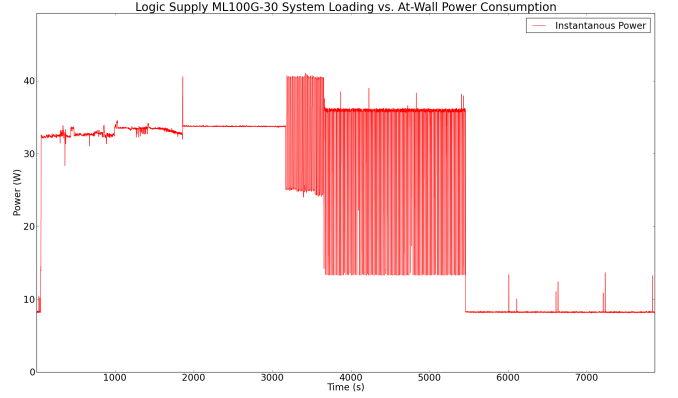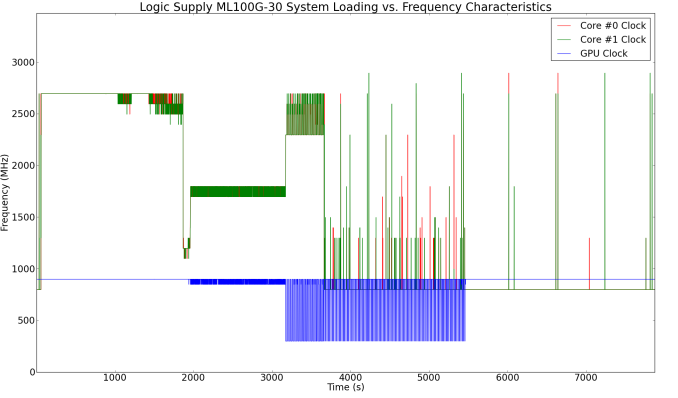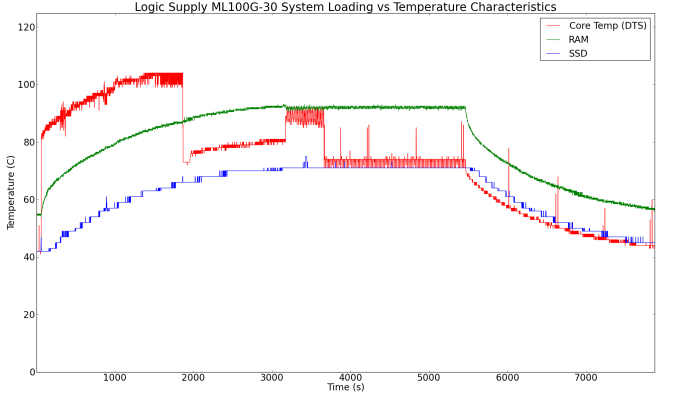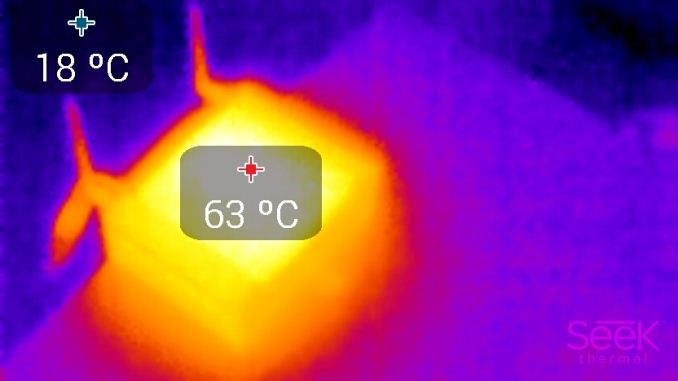Logic Supply ML100G-30 Fanless Broadwell vPro Industrial NUC Review
by Ganesh T S on April 29, 2015 11:30 AM EST- Posted in
- Systems
- Intel
- Fanless
- NUC
- Industrial PC
- Passive Cooling
- Logic Supply
Power Consumption and Thermal Performance
The power consumption at the wall was measured with a 1080p display being driven through one fo the mini-DP porst. In the graphs below, we compare the idle and load power of the Logic Supply ML100G-30 with other low power PCs evaluated before. For load power consumption, we ran Furmark 1.12.0 and Prime95 v27.9 together. Despite the lack of active cooling, the idle power consumption is a bit too high for our liking (considering that we are operating in single-channel memory mode). This may be due to a number of factors - idle power of the Transcend SSD not being particularly attractive and/or power supply inefficiencies and/or vPro as a platform itself may show some increase in idle power consumption. We didn't explore this in enough detail to root cause the behavior.


The load power graph is much more interesting. Even though the system could consume up to 40.56 W, it does not sustain this for an extended duration. This aspect will become evident in the graphs below.
In order to evaluate the efficiency of the thermal design, the at-wall power consumptio as well as the frequencies of the various clocks in the systems and the temperature of the various components in the system were recorded in the course of our thermal stress test. We start with the system at idle, followed by 30 minutes of pure CPU loading. This is followed by another 30 minutes of both CPU and GPU being loaded simultaneously. After this, the CPU load was removed, allowing the GPU to be loaded alone for another 30 minutes.
A look at the power consumption at the wall reveals that the unit has a steady state maximum load power consumption around 34 W, but it can spike up to 40 W if needed. A context to the above graph is given by the frequency and temperature graphs below for the same time span.
The most important thing to observe with the temperature graph is that DTS never goes to 0 - so, junction temperature is never reached. This is achieved by dialing down the core frequency from 2.7 GHz to 2.5 GHz. Since the Core i5-5300U is rated for a 2.3 GHz operation, one shouldn't term this as throttling.
Loading up both the CPU and GPU results in some strange behavior - they manage to share the available headroom by operating between 1.7 GHz - 1.8 GHz and 850 MHz - 900 MHz respectively. However, after around 20 minutes of this sharing, something strange kicks in despite the temperatures and at-wall power consumption being largely stable - the GPU starts oscillating between 300 MHz and 900 MHz, while the CPU cranks up to 2.3 GHz - 2.6 GHz. The temperature also rises correspondingly from 76 C to around 87 C. Removing the CPU load brings the cores to idle at 800 MHz, while the GPU continues to oscillate between 300 MHz and 900 MHz. The thermal solution is able to keep the cores idle around 43 C.
Another important aspect to keep note of while evaluating fanless PCs is the chassis temperature. Using Seek Thermal's thermal imager, we observed the chassis temperature after the at-wall power consumption started the 40 W peaks.
We also took thermal photographs of the other parts of the chassis and they are presented in the gallery below.
The chassis temperatures peak around 65 C, which is a marked improvement over the 80 C we observed in the Core ML320 last year. The ML100G-30 has a better chassis design from a thermal viewpoint and it is made possible due to the increased height of the unit (compared to the ML320).




















34 Comments
View All Comments
Ammaross - Wednesday, April 29, 2015 - link
"Logic Supply HTPC use is not the market (I think) of the model they supplied."You must have missed the term "Industrial" in the title of the review....
mtnman81 - Tuesday, June 23, 2015 - link
Why would you use and industrial computer for a HTPC. Do you just have too much money? That is the only case I can think of. A regular NUC would be much more appropriate for a HTPC. I have one in that very role now. It is the 4th gen i5 model running a 250GB m.2 drive for xmbc and pulls all media files from the network. Without a actual disk needing to turn inside the enclosure it self, it stays extremely cool. The bios are set by default to only cue the fan when needed and running with 16gb DDR3 1600, displaying dual full HDX I am yet to see the fan be cued. The frame of the case being solid metal you can feel that there is nearly no heat to speak of when you hold your hand to it.That being said this is not the application I would ever look at one of the Logic Supply units for. Why would I pay twice as much to get a industrial one for home use when the consumer one fits the bill better anyway since it has built in IR receiver for a remote?
The Logic Supply models do make sense for the application they were intended for. As far as all of you saying that it doesn't have serial and it doesn't have this or that. It has all the interface ports needed for you to be able to adapt it to any application that this "should" be used for. I find it despicable that serial ports are so prevalent in automation. We are the technology side of industry so lets get with the times. I am glad they didn't waste interface real-estate with a dedicated serial port! As far a redundant network connections, your complaint is ridiculous as most automation controllers and proprietary HMI's don't even have redundant network connections. It does have built in Wi-Fi antenna sockets so you could always utilize that if necessary or use a USB to Ethernet adapter. This may industrial rated but it is not allowable as a safety controller and I can not imagine what other process you have that is so critical that you planning on this unit running as the backbone of a critical system. Perhaps you have not appropriately though out your process before you started specking hardware for install.
pekpetrolhead - Thursday, April 30, 2015 - link
Giada F300 is a similar unit to the above, been using as a HTPC for over a year, totally silent and very solid unit.Model
Giada F300
OS
Windows®7,8 & Linux
Processor
Intel® Core™ i5-4200U Processor, 2 Cores / 4 Threads
Chipset
Integrated into CPU
Display
Intel®HD Graphics 4400
Microsoft®DirectX®11
Memory
Not included
One SO-DIMM slot, up to 16GB of DDR3L 1600 MHz
HDD
Not included
Support 2.5inch SATA Ⅲ or SATA Ⅱ Type HDD
Wireless
Not included, optional IEEE 802.11 b/g/n module
LAN
1x Realtek®Gigabit Ethernet Controller
1x Rj45 port on the back pane
Audio
Realtek®High Definition Audio
(5.1) Digital audio via DisplayPort 1.2 connector
1x Audio out &S/PDIF combo jack on the front panel
1x Mic in jack on the front pane
Interface
4x USB3.0 (two on the back panel)
2x USB2.0 (on the back panel)
2x COM Port (one on the back panel)
1x DC-IN jack (19V /12V )
IR
An infrared sensor on the front panel
1x 3.5mm audio jack for extended infrared sensor
Not included Remote Control(Optional )
Size
10.3in x 6.9in x 1.4in
260mm x 175mm x 35mm
Color
Black
Beaver M. - Saturday, May 2, 2015 - link
These mini PCs all have one huge flaw: Not enough USB Ports. And if you want stability and reliability youre not going to start with USB hubs. Period.I rather build an ITX system that wont be much bigger (actually much flatter), has far more power (up to i7) more storage, more RAM and over 3 times as many USB ports.